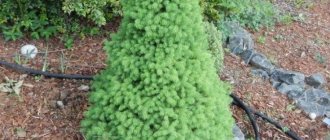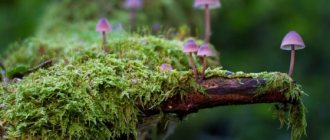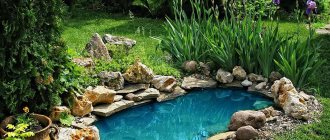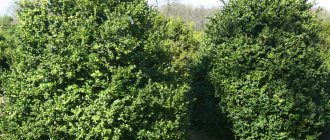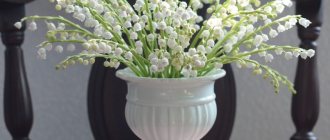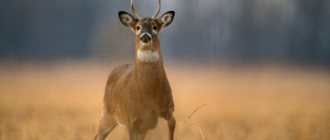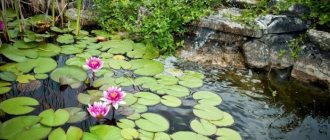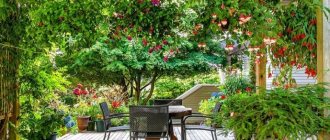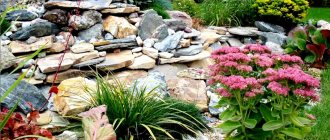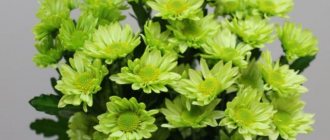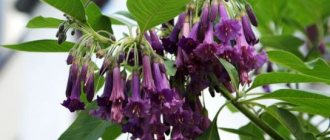Recently, it has become very fashionable among gardeners to create mini-reservoirs in their garden plots: ponds, lakes, and other waterways. It goes without saying that in this case one cannot do without coastal aquatic vegetation, because it is the main decoration of reservoirs. There are many thousands of species of plants living in water, but not all of them are suitable for growing in the middle zone. On this page you will learn the names of aquatic flowers and plants of the coastal zone, adapted to our conditions. You can also get acquainted with the description of aquatic plants and see their photographs.
Perennial aquatic flowers and ornamental herbaceous plants
Aquatic flowers and plants are a real decoration of ponds. But herbaceous aquatic plants are no less interesting, attracting attention with their rich greenery.
Arrow leaf (SAGITTARIA). Chastukhov family.
These are aquatic flowers, which are rhizomatous perennials, rooted at a depth of 10-50 cm. The leaves are dark green, shiny, dense. Flowers in inflorescence are a sparse raceme.
Types and varieties:
Broad-leaved arrowhead (S. LatifoLia) - height 50-70 cm, flowers with a yellow center; arrowhead arrowhead (S. sagittifoLia) - height 30-50 cm, flowers with a red center.
Growing conditions. Planting in reservoirs with standing or slowly flowing water to a depth of 10-50 cm.
Reproduction. By seeds (sowing in spring in containers and then planting in water).
Chastukha (ALISMA). Chastukha family.
A perennial aquatic plant with beautiful ribbed leaves on long petioles. They bloom all summer. The flowers are small, with three petals, arranged in whorls.
Types and varieties:
Chastukha plantain (A. plantagoaquatica) - pink flowers; small-flowered chastuha (A. parviflora) - white flowers.
Growing conditions. These plants live in an aquatic environment in the shallow waters of natural reservoirs. Planting depth 5-10 cm.
Reproduction. By dividing the bush (summer) or seeds (spring).
Elodea
Externally it is a rather simple plant. It is a long stem covered on four sides with small, narrow leaves - the size is approximately 10x3 millimeters. The color is green, although the shade can vary greatly - from light green to brown-green. First of all, it depends on the illumination of the place where the elodea grows, as well as the composition of the water and soil.
The root system is not very powerful, but still the plant usually takes root in the ground, feeling great in almost any conditions. Reaches quite a long length - 2 meters is far from the limit.
In general, the homeland of elodea is North America, and specifically Canada. It is to this circumstance that the plant owes its official name - Canadian Elodea - it came to Europe relatively recently - less than two centuries ago. The first country was Ireland - it was here that Elodea was brought in 1836. It was brought to our country half a century later - approximately in the 80s of the nineteenth century.
The main interest is the amazing growth rate. Once in a new body of water, Elodea begins to grow vigorously, often displacing all other algae that occupy the same niche as Elodea. It is because of this that it received another name - water plague. It is not surprising that first introduced to St. Petersburg, elodea began to spread quickly and today it can be seen in Siberia - right up to Lake Baikal. It causes a lot of problems when navigating on boats and other small vessels, and also causes some damage to the fishing industry.
But it can be an excellent choice for a novice aquarist - having planted Elodea in an aquarium, you can be sure that it will take root even with a novice hobbyist.
Main groups of algae
In general, there are many systems that involve dividing plants of the underwater world into groups. It will be quite difficult to list everything. Therefore, we will focus on one of the simplest ones. It provides for the separation of algae according to their place of growth:
- Coastal. They grow in coastal areas, at shallow depths. Only the lower part of the plant is under water, while most of it is above water. These include reeds, reeds, cattails, horsetails, and arrowheads.
- Aquatic. Algae that do not even attach to the bottom, preferring to spend their entire life in the water column, sometimes rising and sometimes falling, traveling with the current. These are hornwort, nitella, water moss, hara and others.
- Floating. Plants that live only in water, but at the same time stay exclusively on the surface. Some have a powerful root system, while others are practically devoid of it. Of course, they are not fixed in the soil, absorbing the necessary substances directly from the water. This group includes pistia, water buttercup, water chestnut, water kras, duckweed, marsh flower and a number of others.
- Submerged (aka deep-sea). Algae that take root in the soil with the help of long roots, but at the same time expose the main part of themselves to the surface. When listing them, first of all it is worth mentioning the lotus, water lily, egg pods, and orontium.
As you can see, even such a simple system is quite ambiguous - it is not always possible to say exactly which group a particular underwater plant of the ocean, river or tiny stream belongs to. Needless to say, nature is fraught with many amazing mysteries.
How to tell about everything? Perhaps this is simply impossible. Even if you describe underwater plants as briefly as possible, indicating names and photos, you will have to compile a whole book. Therefore, we will limit ourselves to just a few. Some are simply of particular interest, standing out from the standard series. And others are most often found in our country, so every lover of plants and wildlife in general should know about them. And of course, when describing underwater plants, we will attach photos so that the reader can get a more reliable impression of them.
Floating aquatic flowering and herbaceous plants
Watercolor (HYDROCHARIS). Family of watercolors.
Common waterweed (H. morsusranae) is a floating aquatic plant of standing or slowly flowing waters with developed shoots and rounded dense dark green leaves in rosettes on long petioles and white 15-30 cm, flowering all summer.
Growing conditions. Aquatic plant.
Reproduction. Seeds, rosettes of leaves.
Used in ponds.
Water chestnut (TRAPA). Water chestnut family.
The common water chestnut (T. natans) is an annual aquatic herbaceous plant that grows in slow-moving waters. There are thread-like submerged leaves and a beautiful rosette of floating leaves.
Growing conditions . Reservoirs.
Reproduction. Place seeds (nuts) on the bottom of the reservoir in the fall.
Used to decorate natural reservoirs.
Egg pod (NUPHAR). The water lily family.
Yellow egg capsule (N. iutea) is a perennial aquatic flowering plant with a fleshy underwater rhizome and wide, dense, leathery leaves above the water. A large waxy flower appears above them in June. The name of these aquatic flowers is quite justified - the flower really resembles a water capsule. Widely distributed in natural reservoirs of the temperate zone.
Growing conditions. Ponds, lakes with standing or slowly flowing water, at a depth of 30-80 cm.
Reproduction. Seeds (sow freshly harvested), sections of rhizome with renewal bud (at the end of summer). Planting density - 12 pcs. per 1 m2.
Waterlily (NYMPHAEA). The water lily family.
The genus includes about 30 species of aquatic plants growing in water bodies of temperate and tropical zones.
Types and varieties. In the reservoirs of central Russia, white flowering plant (N. alba) grows - a rhizomatous perennial with round, unequal leaves on long petioles floating on the surface of the water. The leaves are green above, reddish below.
Look at the photo of these aquatic flowers - they are all large, mostly white. They have a pronounced aroma.
There are numerous varieties of N. xhybrida:
"Gladstoniana", "Fire Opal"
“Hollandia”, “Rose Arey”, etc.
Growing conditions. These aquatic flowering plants prefer ponds with standing or slowly flowing water and grow at a depth of 30-100 cm.
Reproduction. Seeds (in the fall to the bottom of the reservoir), sections of rhizomes with a renewal bud (at the end of summer in the soil of the reservoir). Planting density - 12 pcs. per 1 m2.
These ornamental aquatic plants are used to decorate ponds.
Cyanobacteria
Now it’s worth briefly talking about underwater plants that are dangerous to humans. Of course, they will not be able to attack a person and eat them like a fly. But still, they can pose a certain danger due to other features.
The most dangerous are cyanobacteria, also known as blue-green algae. This is not one species, but a whole family. Found in fresh and salt waters.
They are not dangerous all the time, but only during the flowering period. Moreover, it is not even the plants themselves that are dangerous, but the substances released when they die. The fact is that after flowering and dispersal of seeds, cyanobacteria die. Moreover, they die en masse - and in suitable conditions they can cover tens of square kilometers of water bodies. When algae rots, it releases toxic substances that pose a danger to all living things - people, aquatic insects, birds, insects. Moreover, depending on the type, toxins attack different organs: liver, eyes, lungs, kidneys, nervous system.
Therefore, when going to swim in warm climates in an unfamiliar place, you should be very careful.
Wetland plants growing near water
Marigold (CALTHA). Ranunculaceae family.
Marigold (C. palustris) is a perennial wetland plant with a short rhizome. The basal leaves are entire, round, bright green, shiny. The flowers are bright yellow, as if varnished. Abundant seed production in July-August. More often in gardens, the double form of this species is grown - marsh marigold "Multiplex".
Growing conditions. Sunny places with clay soils that retain water well.
Reproduction. By dividing the bush at the end of summer. The bush grows slowly, so division is carried out after 6-7 years. It is propagated by freshly collected seeds; they germinate the following spring, but the seedlings bloom in the 5-6th year. Planting density - 9 pcs. per 1 m2.
An excellent plant for decorating the banks of reservoirs and in “natural garden” flower beds that imitate wet meadows. Here marigold is planted together with loosestrife, drooping sedge, knotweed, crayfish, etc.
Reed (SCIRPUS). The sedge family.
Lake reed (S. lacustris) is a perennial with a thick creeping rhizome 100-120 cm high, growing along the banks of reservoirs in Europe and North America. The inflorescence is paniculate, the leaves are subulate.
Growing conditions. Wet, low places along the banks of reservoirs.
Reproduction. By dividing the bush (in spring and late summer), by seeds (sowing before winter).
Swamp flower (NYMPHOIDES). A family of shift workers.
Cottonweed (N. peltata) is an aquatic perennial with a rhizome, round shiny leaves on long petioles and numerous flowers emerging from the leaf axil. The name of this aquatic plant speaks for itself - it prefers exclusively marshy areas.
Growing conditions. Reservoirs with standing or slowly flowing water, depth 20-100 cm.
Reproduction. By seeds (into the ground under water), by dividing the bush.
Used when decorating reservoirs.
